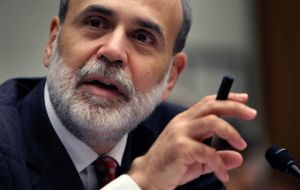MercoPress. South Atlantic News Agency
Bernanke argues strong demand for commodities is depressing US dollar value
 “The direction of causality runs from commodity prices to the US dollar rather than the other way around”, says Fed chairman
“The direction of causality runs from commodity prices to the US dollar rather than the other way around”, says Fed chairman US Federal Reserve rejected criticism that its actions (‘accommodative monetary policy’) have pushed down the foreign exchange value of the US dollar and thereby boosted the price of commodities, adding that the Fed is “fully committed” to maintaining the dollar’s purchasing power and to keeping inflation in check.
Addressing this week the International Monetary Conference in Atlanta on the ‘US Economic Outlook’, Fed Chairman Ben Bernanke said that supply and demand fundamentals account for most of the recent movements in commodity prices and that the authorities of emerging economies in risk of overheating “have a range of fiscal, monetary, exchange rate, and other tools that can be used to address any overheating that may occur”
Ben Bernanke admitted slow growth in the United States and a persistent trade deficit are “additional, more fundamental sources of recent declines in the dollar's value”, in particular, as the US is a major oil importer, any geopolitical or other shock that increases the global price of oil will worsen the US trade balance and economic outlook, which tends to depress the dollar.
However “in this case the direction of causality runs from commodity prices to the US dollar rather than the other way around. The best way for the Federal Reserve to support the fundamental value of the dollar in the medium term is to pursue our dual mandate of maximum employment and price stability, and we will certainly do that”.
Bernanke supported his argument saying that since February 2009, the trade-weighted dollar has fallen by about 15% but since that date oil prices have risen 160% and non-fuel commodity prices are up by about 80%, implying that “the dollar's decline can explain, at most, only a small part of the rise in oil and other commodity prices; indeed, commodity prices have risen dramatically when measured in terms of any of the world's major currencies, not just the dollar”.
But even this calculation overstates the role of monetary policy, as many factors other than monetary policy affect the value of the dollar. For example, the decline in the dollar since February 2009 followed a comparable increase in the dollar, which largely reflected flight-to-safety flows triggered by the financial crisis in the latter half of 2008, and “the dollar's decline since then in substantial part reflects the reversal of those flows as the crisis eased”.
Further on Bernanke says low interest rates have been blamed for pushing up commodity prices by reducing the cost of holding inventories and thus boosting commodity demand or by encouraging speculators to push commodity futures prices above their fundamental levels.
But “in either case, if such forces were driving commodity prices materially and persistently higher, we should see corresponding increases in commodity inventories, as higher prices curtailed consumption and boosted production relative to their fundamental levels. In fact, inventories of most commodities have not shown sizable increases over the past year as prices rose; indeed, increases in prices have often been associated with lower rather than higher levels of inventories, likely reflecting strong demand or weak supply that tends to put pressure on available stocks”.
Finally the Fed chairman targets those who have suggested that very low interest rates in the United States and other advanced economies have created risks of economic overheating in emerging market economies and have thus indirectly put upward pressures on commodity prices.
But in fact, “most of the recent rapid economic growth in emerging market economies appears to reflect a bounce-back from the previous recession and continuing increases in productive capacity, as their technologies and capital stocks catch up with those in advanced economies, rather than being primarily the result of monetary conditions in those countries”.
And more fundamentally whatever the source of the recent growth in the emerging markets, “the authorities in those economies clearly have a range of fiscal, monetary, exchange rate, and other tools that can be used to address any overheating that may occur”.
As in all countries, the primary objective of monetary policy in the United States should be to promote economic growth and price stability at home, which in turn supports a stable global economic and financial environment.




Top Comments
Disclaimer & comment rulesCommenting for this story is now closed.
If you have a Facebook account, become a fan and comment on our Facebook Page!